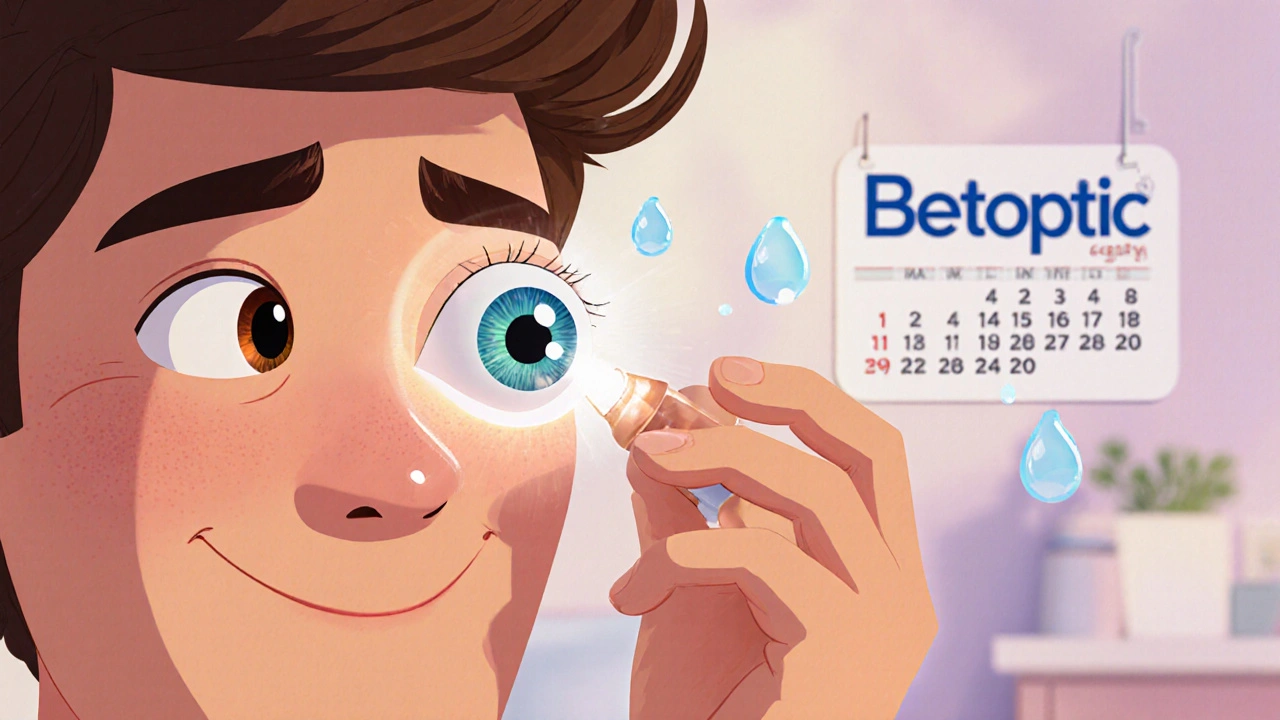Betoptic: What It Is, How It Works, and When It's Used for Glaucoma
 Jun, 16 2025
Jun, 16 2025
Betoptic is a prescription eye drop used to lower high pressure inside the eye, a condition known as intraocular pressure. It’s most commonly prescribed for people with open-angle glaucoma or ocular hypertension. Unlike some other glaucoma treatments that work by increasing fluid drainage, Betoptic reduces the amount of fluid your eye produces in the first place. This makes it a first-line option for many patients, especially those who can’t tolerate other medications or have heart conditions that limit their choices.
How Betoptic Works
The active ingredient in Betoptic is betaxolol, a selective beta-1 adrenergic blocker. That means it targets specific receptors in the ciliary body - the part of your eye that makes aqueous humor, the fluid that fills the front chamber. By blocking these receptors, Betoptic slows down fluid production. Less fluid means less pressure building up inside the eye.
High eye pressure is dangerous because it slowly damages the optic nerve. Over time, this can lead to blind spots, tunnel vision, and eventually permanent vision loss. Betoptic doesn’t cure glaucoma, but it stops or slows the damage. Many patients use it for years without major side effects, as long as they stick to the dosing schedule.
Who Uses Betoptic
Betoptic is typically prescribed for adults with open-angle glaucoma - the most common type, where the drainage angle of the eye is open but not working properly. It’s also used for ocular hypertension, which means elevated eye pressure without visible nerve damage yet. In these cases, doctors use Betoptic to prevent future damage.
It’s often chosen over other beta blockers because it’s selective. Non-selective beta blockers like timolol can affect the heart and lungs more strongly. Betaxolol has less impact on breathing and heart rate, making it safer for people with asthma, mild COPD, or certain heart rhythm issues. That’s why many eye specialists start with Betoptic when they want a beta blocker but need to avoid broad effects.
How to Use Betoptic Correctly
Using eye drops properly matters more than most people realize. If you don’t apply them right, you might not get the full benefit.
- Wash your hands before handling the bottle.
- Tilt your head back and pull down your lower eyelid to make a small pocket.
- Hold the dropper close to your eye without touching it. Squeeze one drop into the pocket.
- Close your eye gently for 1 to 2 minutes. Press lightly on the inner corner of your eye near your nose. This blocks the tear duct and keeps the medicine in your eye longer.
- If you need more than one drop or another eye medicine, wait at least 5 minutes between them.
Most people use Betoptic twice a day - once in the morning and once in the evening. Don’t skip doses, even if you feel fine. Glaucoma doesn’t cause pain or obvious symptoms until damage is already done. Consistency is what protects your vision.
Side Effects and Risks
Betoptic is generally well-tolerated, but side effects do happen. The most common ones are mild and temporary:
- Burning or stinging when you put the drops in
- Blurred vision for a few minutes after use
- Dry or itchy eyes
- Headache or dizziness
More serious side effects are rare but possible. These include slow heart rate, low blood pressure, trouble breathing, or worsening heart failure. If you feel unusually tired, short of breath, or your heart is beating slower than normal, contact your doctor right away.
People with severe heart conditions, very low blood pressure, or certain types of heart block should not use Betoptic. If you’re pregnant or breastfeeding, talk to your doctor - there’s limited data, but it’s generally considered low risk when used as directed.

What to Avoid
Don’t share your Betoptic bottle with anyone. Even if it looks clean, eye drops can carry bacteria that cause serious infections. Always keep the cap tightly closed and store the bottle at room temperature. Once opened, most bottles last 28 days - after that, throw them away, even if there’s liquid left.
Also, avoid wearing contact lenses while using Betoptic. The preservative in the drops can stick to soft lenses and irritate your eyes. Wait at least 15 minutes after using the drops before putting your lenses back in.
If you’re taking other medications - especially oral beta blockers, calcium channel blockers, or antidepressants - tell your eye doctor. Some drugs can interact with Betoptic and increase the risk of low heart rate or low blood pressure.
How Long Until It Works
You won’t feel Betoptic working. There’s no immediate sensation of pressure dropping. But within a few hours after the first dose, your eye pressure starts to decrease. The full effect usually takes about 2 weeks to stabilize. Your doctor will likely schedule a follow-up visit to check your pressure with a tonometer - a quick, painless test.
Don’t stop using Betoptic just because your pressure seems normal. Glaucoma is a chronic condition. Stopping treatment, even for a few days, can cause pressure to spike again and damage your optic nerve.
Alternatives to Betoptic
If Betoptic doesn’t lower your pressure enough, or if you develop side effects, your doctor may switch you to another medication. Common alternatives include:
- Timolol - a non-selective beta blocker, more effective at lowering pressure but higher risk for lung and heart side effects
- Latanoprost - a prostaglandin analog that increases fluid drainage, often used once daily
- Brinzolamide - a carbonic anhydrase inhibitor that also reduces fluid production
- Combination drops - like Betoptic S with dorzolamide, which combines two mechanisms in one bottle
Some patients need two or more medications to keep pressure under control. Others eventually require laser treatment or surgery. But for many, Betoptic alone is enough to protect their vision for years.

Cost and Availability
Betoptic is available as a generic (betaxolol hydrochloride), which makes it more affordable than brand-name versions. In the UK, it’s prescribed through the NHS and usually costs little to nothing for patients. In the US, generic versions can range from $10 to $40 per bottle depending on the pharmacy and insurance. Always ask your pharmacist about patient assistance programs if cost is a concern.
It’s not sold over the counter. You need a prescription from an ophthalmologist or optometrist after a full eye exam, including pressure testing and optic nerve assessment.
What Happens If You Miss a Dose
If you forget a dose, take it as soon as you remember. But if it’s almost time for your next dose, skip the missed one. Don’t double up. Taking too much can cause your heart rate to drop too low or your blood pressure to fall dangerously.
Keep a daily log or set phone reminders. Missing doses is one of the top reasons glaucoma progresses despite treatment.
Can Betoptic cure glaucoma?
No, Betoptic cannot cure glaucoma. It helps control intraocular pressure, which slows or stops further damage to the optic nerve. Glaucoma is a lifelong condition, and treatment is about protecting vision, not reversing damage that’s already happened.
Is Betoptic safe for people with asthma?
Betoptic is generally safer for people with asthma than non-selective beta blockers like timolol because it targets beta-1 receptors more specifically, which are mainly in the heart. It has less effect on the lungs. But if you have severe asthma, your doctor may still choose a different medication to be extra cautious.
How long do I need to use Betoptic?
Most people use Betoptic for the rest of their lives. Glaucoma doesn’t go away, and stopping treatment can cause eye pressure to rise again. As long as it’s working and you’re not having serious side effects, your doctor will recommend continuing it indefinitely.
Can I use Betoptic with other eye drops?
Yes, but you need to wait at least 5 minutes between each drop. Putting them in too close together can wash out the first one before it has time to work. Always use your least irritating drop first, or follow your doctor’s specific order.
Does Betoptic cause weight gain or fatigue?
Weight gain isn’t a known side effect of Betoptic. Fatigue or drowsiness can happen, but it’s uncommon. If you feel unusually tired, it might be due to low blood pressure or an interaction with another medication. Talk to your doctor if this lasts more than a few days.
Final Thoughts
Betoptic isn’t flashy. It doesn’t promise instant results or dramatic improvements. But for millions of people around the world, it’s the quiet hero that keeps their vision intact. It’s simple, reliable, and effective when used correctly. The key isn’t finding the strongest drop - it’s sticking with the one that works for your body, your lifestyle, and your long-term eye health.
If you’ve been prescribed Betoptic, don’t treat it like an optional extra. It’s part of your daily health routine - like brushing your teeth or taking your blood pressure medication. Protecting your vision is a marathon, not a sprint. Betoptic helps you stay in the race.